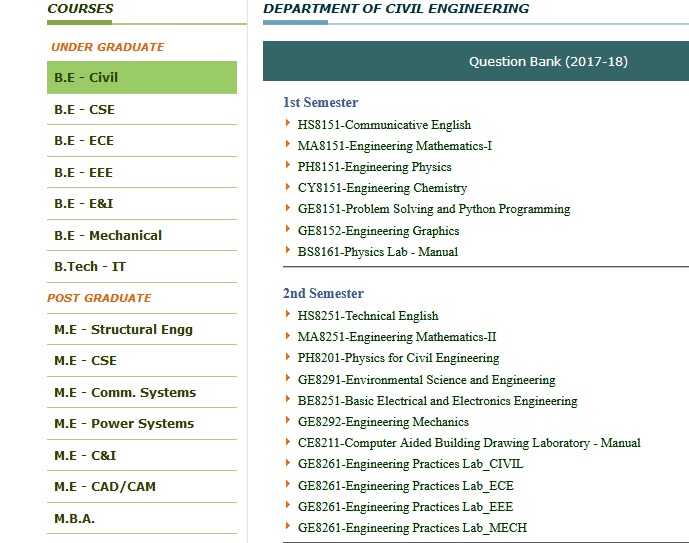CS6303 Computer Architecture B.E Question Bank : valliammai.co.in
Name of the College : Valliammai Engineering College
University : Anna University
Department : Information Technology
Subject Code/Name : CS6303-Computer Architecture
Degree : B.Tech – IT
Year : II
Semester : III
Document Type : Question Bank
Website : valliammai.co.in
Download :https://www.pdfquestion.in/uploads/va…chitecture.pdf
Valliammai Computer Architecture Question Paper
Unit-I
Overview And Instructions :
Part- A :
1.What are the eight great ideas in computer architecture?
2.What are the five classic components of a computer?
3.What is the function of data path and control path?
Related : Valliammai Engineering College CS6304 Analog & Digital Communication B.E Question Bank : www.pdfquestion.in/2854.html
4.What is instruction set Architecture?
5.Define application binary interface
6.Differentiate DRAM and SRAM.
7.Compare Volatile and nonvolatile memory.
8.List the advantages of Network Computer.
9.Define VLSI
10.Differentiate Throughput and Response Time
11.Write the CPU performance equation.
12.If computer A runs a program in 10 seconds, and computer B runs the same program in 15 seconds, how much faster is A over B.
13.What are the basic components of performance?

14.Write the formula for CPU execution time for a program
15.Write the formula for CPU clock cycles required for a program.
16.How will you measure the dynamic power dissipation?
17.Define – Stored Program Concepts
18.What are the fields in an MIPS instruction?
19.Write an example for immediate operand
20.Write operations to perform sum of four variables b,c,d,e and store the result in a.
21.List the advantages of multiprocessor over uniprocessor.
22.What are the different types ofoperands? Give examples
23.List the different addressing modes
Part-B :
1.i)Discuss in detail about Eight great ideas of computer Architecture.(8)
ii) Explain in detail about Technologies for Building Processors and Memory (8)
2.Explain the various components of computer System with neat diagram (16)
3.Discuss in detail the various measures of performance of a computer(16)
4.Define Addressing mode and explain the basic addressing modes with an example for each.
5.Explain operations and operands of computer Hardware in detail (16)
6.i)Discuss the Logical operations and control operations of computer (12)
ii)Write short notes on Power wall(6)
7.Consider three different processors P1, P2, and P3 executing the same instruction set. P1 has a 3 GHz clock rate and a CPI of 1.5. P2 has a 2.5 GHz clock rate and a CPI of 1.0. P3 has a 4.0 GHz clock rate and has a CPI of 2.2.
a.Which processor has the highest performance expressed in instructions per second?
b.If the processors each execute a program in 10 seconds, find the number of
cycles and the number of instructions.
c.We are trying to reduce the execution time by 30% but this leads to an increase of 20% in the CPI. What clock rate should we have to get this time reduction?
8. Assume a program requires the execution of 50 × 106 FP instructions,110 × 106 INT instructions, 80 × 106 L/S instructions, and 16 × 106 branchinstructions. The CPI for each type of instruction is 1, 1, 4 and 2 respectively.Assume that the processor has a 2 GHz clock rate.
a. By how much must we improve the CPI of FP instructions ifwe want the program to run two times faster?
b. By how much must we improve the CPI of L/S instructionsif we want the program to run two times faster?
c. By how much is the execution time of the program improvedif the CPI of INT and FP instructions is reduced by 40% and the CPI of L/S and Branch is reduced by 30%?
9.Explain Branching operations with example
10.Explain the following addressing modes in detail with diagram
i)Immediate addressing ii)Register addressing, iii)Baseor displacement addressing,
iv)PC-relative addressing v)Pseudodirect addressing
Unit-II
Arithmetic Operations :
Part-A :
1.Add 610 to 710 in binary and Subtract 610 from 710 in binary
2.Write the overflow conditions for addition and subtraction.
3.Draw the Multiplication hardware diagram
4.List the steps of multiplication algorithm
5.What is fast multiplication?
6.List the steps of division algorithm
7.What is scientific notation and normalization? Give an example
8.Give the representation of single precision floating point number
9.Define overflow and under flow with examples
10.Give the representation of double precision floating point number
11.What are the floating point instructions in MIPS?
12.What are the steps of floating point addition?
13.List the steps of floating point multiplication
14.Define – Guard and Round
15.Write the IEEE 754 floating point format.
16.What is meant by sub-word parallelism?
17.Multiply 100010 * 100110.
Part- B :
1.Explain the Multiplication algorithm in detail with diagram and examples
2.Discuss in detail about division algorithm in detail with diagram and examples
3.Explain in detail about floating point addition with example
4.Explain in detail about floating point multiplication
5.Give the algorithm for multiplication of signed 2’s complement numbers and illustrate with an example
6.Multiply the following pair of signed 2’s complement numbers :A = 010111, B = 101100.
7.Add the numbers 0.510 and -0.437510using binary Floating point Addition algorithm
8.Multiply 1.10 10X 1010and 9.200X10-5 using binary Floating point multiplication
9. Calculate the division of A and B A : 3.264 X 103 B: 6.52 X 102
10 .Show the IEEE 754 binary representation of the number -0.75 10in single and double precision